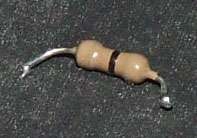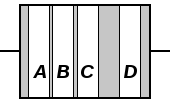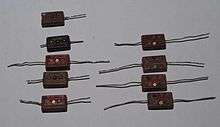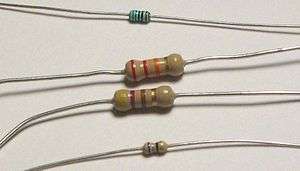Electronic color code

The electronic color code is used to indicate the values or ratings of electronic components, usually for resistors, but also for capacitors, inductors, diodes and others. A separate code, the 25-pair color code, is used to identify wires in some telecommunications cables.
The electronic color code was developed in the early 1920s by the Radio Manufacturers Association (now part of Electronic Industries Alliance[1] (EIA)), and was published as EIA-RS-279. The current international standard is IEC 60062.[2] published by International Electrotechnical Commission.
Colorbands were used because they were easily and cheaply printed on tiny components. However, there were drawbacks, especially for color blind people. Overheating of a component or dirt accumulation, may make it impossible to distinguish brown from red or orange. Advances in printing technology have now made printed numbers practical on small components. Where passive components come in surface mount packages, their values are identified with printed alphanumeric codes instead of a color code.
Resistor color-coding






To distinguish left from right there is a gap between the C and D bands.
- band A is the first significant figure of component value (left side)
- band B is the second significant figure (some precision resistors have a third significant figure, and thus five bands).
- band C is the decimal multiplier
- band D if present, indicates tolerance of value in percent (no band means 20%)
For example, a resistor with bands of yellow, violet, red, and gold has first digit 4 (yellow in table below), second digit 7 (violet), followed by 2 (red) zeros: 4,700 ohms. Gold signifies that the tolerance is ±5%, so the real resistance could lie anywhere between 4,465 and 4,935 ohms.
Resistors manufactured for military use may also include a fifth band which indicates component failure rate (reliability); refer to MIL-HDBK-199 for further details.
Tight tolerance resistors may have three bands for significant figures rather than two, or an additional band indicating temperature coefficient, in units of ppm/K.
All coded components have at least two value bands and a multiplier; other bands are optional.
The standard color code per EN 60062:2005 is as follows:
| Color | Significant figures |
Multiplier | Tolerance | Temp. Coefficient (ppm/K) | ||||||
|---|---|---|---|---|---|---|---|---|---|---|
| Black | 0 | ×100 | – | 250 | U | |||||
| Brown | 1 | ×101 | ±1% | F | 100 | S | ||||
| Red | 2 | ×102 | ±2% | G | 50 | R | ||||
| Orange | 3 | ×103 | – | 15 | P | |||||
| Yellow | 4 | ×104 | (±5%) | – | 25 | Q | ||||
| Green | 5 | ×105 | ±0.5% | D | 20 | Z | ||||
| Blue | 6 | ×106 | ±0.25% | C | 10 | Z | ||||
| Violet | 7 | ×107 | ±0.1% | B | 5 | M | ||||
| Gray | 8 | ×108 | ±0.05% (±10%) | A | 1 | K | ||||
| White | 9 | ×109 | – | – | ||||||
| Gold | – | ×10−1 | ±5% | J | – | |||||
| Silver | – | ×10−2 | ±10% | K | – | |||||
| None | – | – | ±20% | M | – | |||||
Resistors use preferred numbers for their specific values, which are determined by their tolerance. These values repeat for every decade of magnitude: 6.8, 68, 680, and so forth. In the E24 series the values are related by the 24th root of 10, while E12 series are related by the 12th root of 10, and E6 series by the 6th root of 10. The tolerance of device values is arranged so that every value corresponds to a preferred number, within the required tolerance.
Zero ohm resistors are made as lengths of wire wrapped in a resistor-shaped body which can be substituted for another resistor value in automatic insertion equipment. They are marked with a single black band.[4]
The 'body-end-dot' or 'body-tip-spot' system was used for radial-lead (and other cylindrical) composition resistors sometimes still found in very old equipment; the first band was given by the body color, the second band by the color of the end of the resistor, and the multiplier by a dot or band around the middle of the resistor. The other end of the resistor was colored gold or silver to give the tolerance, otherwise it was 20%.[5]
Capacitor color-coding
Capacitors may be marked with 4 or more colored bands or dots. The colors encode the first and second most significant digits of the value, and the third color the decimal multiplier in picofarads. Additional bands have meanings which may vary from one type to another. Low-tolerance capacitors may begin with the first 3 (rather than 2) digits of the value. It is usually, but not always, possible to work out what scheme is used by the particular colors used. Cylindrical capacitors marked with bands may look like resistors.
| Color | Significant digits | Multiplier | Capacitance tolerance | Characteristic | DC working voltage | Operating temperature | EIA/vibration | |
|---|---|---|---|---|---|---|---|---|
| Black | 0 | 1 | — | — | — | −55 °C to +70 °C | 10 to 55 Hz | |
| Brown | 1 | 10 | ±1% | B | 100 | — | — | |
| Red | 2 | 100 | ±2% | C | — | −55 °C to +85 °C | — | |
| Orange | 3 | 1000 | — | D | 300 | — | — | |
| Yellow | 4 | 10000 | — | E | — | −55 °C to +125 °C | 10 to 2000 Hz | |
| Green | 5 | 100000 | ±0.5% | F | 500 | — | — | |
| Blue | 6 | 1000000 | — | — | — | −55 °C to +150 °C | — | |
| Violet | 7 | 10000000 | — | — | — | — | — | |
| Grey | 8 | — | — | — | — | — | — | |
| White | 9 | — | — | — | — | — | EIA | |
| Gold | — | — | ±5%* | — | 1000 | — | — | |
| Silver | — | — | ±10% | — | — | — | — | |
*or ±0.5 pF, whichever is greater.
Extra bands on ceramic capacitors identify the voltage rating class and temperature coefficient characteristics.[5] A broad black band was applied to some tubular paper capacitors to indicate the end that had the outer electrode; this allowed this end to be connected to chassis ground to provide some shielding against hum and noise pickup.
Polyester film and "gum drop" tantalum electrolytic capacitors are also color-coded to give the value, working voltage and tolerance.
Diode part number
The part number for diodes is sometimes also encoded as colored rings around the diode, using the same numerals as for other parts. The JEDEC "1N" prefix was assumed, and the balance of the part number was given by three or four rings. The 1N4148 would then be color coded as yellow (4), brown (1), yellow (4), grey (8).
Postage stamp capacitors and war standard coding

Capacitors of the rectangular "postage stamp" form made for military use during World War II used American War Standard (AWS) or Joint Army Navy (JAN) coding in six dots stamped on the capacitor. An arrow on the top row of dots pointed to the right, indicating the reading order. From left to right the top dots were: either black, indicating JAN mica, or silver, indicating AWS paper; first significant digit; and second significant digit. The bottom three dots indicated temperature characteristic, tolerance, and decimal multiplier. The characteristic was black for ±1000 ppm/°C, brown for ±500, red for ±200, orange for ±100, yellow for −20 to +100 ppm/°C, and green for 0 to +70 ppm/°C.
A similar six-dot code by EIA had the top row as first, second and third significant digits and the bottom row as voltage rating (in hundreds of volts; no color indicated 500 volts), tolerance, and multiplier. A three-dot EIA code was used for 500 volt 20% tolerance capacitors, and the dots signified first and second significant digits and the multiplier. Such capacitors were common in vacuum tube equipment and in surplus for a generation after the war but are unavailable now.[6]
Mnemonics
A useful mnemonic matches the first letter of the color code, by order of increasing magnitude. Here are two that includes tolerance codes gold, silver, and none:
- Bad beer rots our young guts but vodka goes well – get some now.[7]
'B.B.'ROY of
Great Britain
had a
Very Good
Wife who wore
Gold and
Silver
Necklace.
The colors are sorted in the order of the visible light spectrum: red (2), orange (3), yellow (4), green (5), blue (6), violet (7). Black (0) has no energy, brown (1) has a little more, white (9) has everything and grey (8) is like white, but less intense.[8]
Examples

From top to bottom:
- Green-Blue-Black-Black-Brown
- 56 ohms ± 1%
- Red-Red-Orange-Gold
- 22,000 ohms ± 5%
- Yellow-Violet-Brown-Gold
- 470 ohms ± 5%
- Blue-Gray-Black-Gold
- 68 ohms ± 5%
The physical size of a resistor is indicative of the power it can dissipate, not of its resistance.
Transformer wiring color codes
Power transformers used in North American vacuum-tube equipment were often color-coded to identify the leads. Black was the primary connection, red secondary for the B+ (plate voltage), red with a yellow tracer was the center tap for the B+ full-wave rectifier winding, green or brown was the heater voltage for all tubes, yellow was the filament voltage for the rectifier tube (often a different voltage than other tube heaters). Two wires of each color were provided for each circuit, and phasing was not identified by the color code.
Audio transformers for vacuum tube equipment were coded blue for the finishing lead of the primary, red for the B+ lead of the primary, brown for a primary center tap, green for the finishing lead of the secondary, black for grid lead of the secondary, and yellow for a tapped secondary. Each lead had a different color since relative polarity or phase was more important for these transformers. Intermediate-frequency tuned transformers were coded blue and red for the primary and green and black for the secondary.[6]
Other wiring codes
Wires may be color-coded to identify their function, voltage class, polarity, phase or to identify the circuit in which they are used. The insulation of the wire may be solidly colored, or where more combinations are needed, one or two tracer stripes may be added. Some wiring color codes are set by national regulations, but often a color code is specific to a manufacturer or industry.
Building wiring under the US National Electrical Code and the Canadian Electrical Code is identified by colors to show energized and neutral conductors, grounding conductors and to identify phases. Other color codes are used in the UK and other areas to identify building wiring or flexible cable wiring.
Thermocouple wires and extension cables are identified by color code for the type of thermocouple; interchanging thermocouples with unsuitable extension wires destroys the accuracy of the measurement.
Automotive wiring is color-coded but standards vary by manufacturer; differing SAE and DIN standards exist.
Modern personal computer peripheral cables and connectors are color-coded to simplify connection of speakers, microphones, mice, keyboards and other peripherals, usually according to the PC99 scheme.
A common convention for wiring systems in industrial buildings is; black jacket – AC less than 1000 volts, blue jacket – DC or communications, orange jacket – medium voltage 2300 or 4160 V, red jacket 13,800 volts or higher. Red-jacketed cable is also used for fire alarm wiring, but has a much different appearance, since it operates at relatively low voltages.
Local area network cables may also have jacket colors identifying, for example, process control network vs. office automation networks, or to identify redundant network connections, but these codes vary by organization and facility.
See also
| Wikimedia Commons has media related to Electronic color code. |
- Color code
- Electrical wiring — AC power wiring inside buildings, including standard color codes
References
- ↑ EIA
- ↑ IEC 60062:2004 Title: "Marking codes for resistors and capacitors" (IEC Webstore)
- ↑ VR37 High ohmic/high voltage resistors (PDF).Vishay datasheet, VR37 High ohmic/high voltage resistors
- ↑ NIC Components Corp. NZO series zero-ohm resistors.
- 1 2 Reference Data for Radio Engineers, Federal Telephone and Radio Corporation, 2nd edition, 1946 page 52
- 1 2 Tony Dorbuck (ed),The Radio Amateur's Handbook Fifty Fifth (1978 edition), The American Radio Relay League, Connecticut 1977, no ISBN, Library of congress card no. 41-3345, pages 553–554
- ↑ The Mnemonics Page – Dean Campbell, Bradley University Chemistry Department
- ↑ Preston R. Clement and Walter Curtis Johnson (1960). Electrical Engineering Science. McGraw-Hill. p. 115.
External links
- Marking codes for resistors and capacitors Preview of IEC 60062:2004
- Standard E6 to E192 decade values Handy reference
- Multi-purpose resistor code converter (4 and 5 band, mobile-friendly, shows nearest standard value)
- 6 band resistor color code calculator (easy lookup, 4 and 5 band calculators also available)
- Resistor color code calculator (Used to explore E-ranges and color codes.)
- Guide to SMD resistor codes, including alphanumeric codes
- Resistor color code calculator (4 and 5 band, responsive, visual user interface)